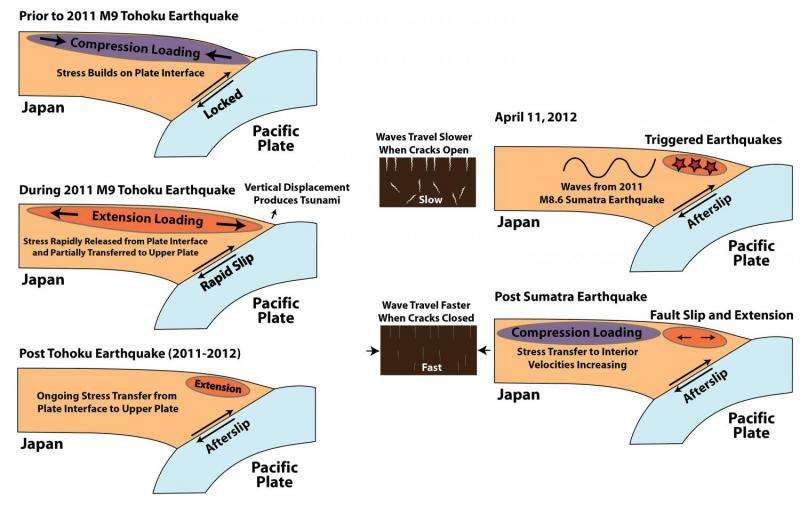October 19, 2015 report
Researchers find cascading elastic perturbation likely contributed to small earthquakes in Japan

(Phys.org)—A team of researchers with members from Los Alamos National Laboratory, MIT and the University of Tokyo, has found evidence that suggests elastic disturbance caused by one earthquake may be one of the causes of another earthquake occurring in a far distant location. In their paper published in the journal Science Advances, the team describes their study of seismic activity in Japan following an earthquake that occurred in the Indian Ocean, just days before.
As the authors note, prior research has revealed sufficient evidence to finger earthquakes happening in one place "causing" an earthquake to occur in another place—using the word "cause" is, however, used in the context of a tipping point, rather than as an underlying factor—for one earthquake to cause another, the second must be nearly ready to go. Such chain-reactions can occur because seismic waves are able to travel great distances through rock. In this new effort, the researchers suggest that seismic waves from one earthquake can cause an elastic disturbance in a distant place, pushing a relatively fragile area into an earthquake.
The researchers came to this conclusion after studying seismic data following an earthquake in the Indian Ocean back in April of 2012—just 30 and 50 hours later, two small earthquakes occurred off the eastern coast of Japan. Though the quakes were 3,900 miles apart, the researchers believe they have found a link between them.
In studying seismic and GPS data for the time interval of the earthquake in the Indian Ocean, and afterwards, the team found that the quakes occurred in a line formed from the two small quake epicenters and the larger one in the Indian Ocean—a phenomenon they suggest would likely have an odds of occurring without a link of just 1 in 358. They also found a sharp rise in seismic activity in the surrounding area. They propose that seismic waves from the Indian Ocean quake caused what they describe as an elastic disturbance, where material at the fault line was changed, setting off an earthquake in a sensitive place. They also suggest that such an elastic disturbance is much more likely to occur in a place that is still healing from a prior seismic event—in this case, from the devastating 9.0 Tohoku earthquake of 2011.
The researchers are not suggesting their work will help predict earthquakes, instead they believe that their findings offer more information on the nature of the Earth's crust and how it behaves under different conditions.
More information: A. A. Delorey et al. Cascading elastic perturbation in Japan due to the 2012 Mw 8.6 Indian Ocean earthquake, Science Advances (2015). DOI: 10.1126/sciadv.1500468
Abstract
Since the discovery of extensive earthquake triggering occurring in response to the 1992 Mw (moment magnitude) 7.3 Landers earthquake, it is now well established that seismic waves from earthquakes can trigger other earthquakes, tremor, slow slip, and pore pressure changes. Our contention is that earthquake triggering is one manifestation of a more widespread elastic disturbance that reveals information about Earth's stress state. Earth's stress state is central to our understanding of both natural and anthropogenic-induced crustal processes. We show that seismic waves from distant earthquakes may perturb stresses and frictional properties on faults and elastic moduli of the crust in cascading fashion. Transient dynamic stresses place crustal material into a metastable state during which the material recovers through a process termed slow dynamics. This observation of widespread, dynamically induced elastic perturbation, including systematic migration of offshore seismicity, strain transients, and velocity transients, presents a new characterization of Earth's elastic system that will advance our understanding of plate tectonics, seismicity, and seismic hazards.
Journal information: Science Advances
© 2015 Phys.org

















